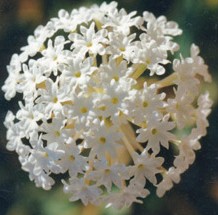Sweet sand-verbena facts for kids
Quick facts for kids Sweet sand-verbena |
|
|---|---|
 |
|
| Scientific classification | |
| Genus: |
Abronia
|
| Species: |
fragrans
|
Abronia fragrans, also known as the sweet sand-verbena or prairie snowball, is a type of sand verbena. This plant is known for its sweet-smelling flowers.
Contents
What is Sweet Sand-Verbena?
The sweet sand-verbena is a plant that lives for many years. It can grow upright or spread out, reaching about 8 to 40 inches (20 to 102 cm) tall. It has a main root that goes deep into the ground. Its stems are sticky and hairy, growing from about 7 inches to 3.3 feet (18 to 100 cm) long.
The plant's flowers grow in clusters of 25 to 80 at the end of the stems. They are usually white, but some might have hints of green, lavender, or pink. The leaves are sticky and grow opposite each other on the stem. They can be up to 3.5 inches (8.89 cm) long and 1.2 inches (3 cm) wide. After flowering, the plant produces small, egg-shaped fruits. These fruits are shiny and can be black or brown.
Plant Names and History
There is some discussion among scientists about how to classify Abronia fragrans. Some think it's a separate plant from Abronia elliptica. Others believe they are the same. These differences are based on things like the shape of the fruit and how hairy the plant parts are.
Thomas Nuttall first collected this plant in 1834 near the Platte River. William Jackson Hooker officially named it in 1853. The name fragrans means 'fragrant' in Latin. This refers to the sweet smell of its flowers. The genus name Abronia comes from a Greek word meaning "delicate."
Where Sweet Sand-Verbena Grows
Sweet sand-verbena is found naturally in a wide area. It grows from northern Arizona to western Texas and Oklahoma. You can also find it north through the Rocky Mountains and western plains of the United States. Its range extends south into Chihuahua, Mexico.
This plant likes to grow in prairies, plains, and savannas. It prefers loose, dry, and sandy soils.
When Sweet Sand-Verbena Blooms
The flowers of the sweet sand-verbena have a special habit. They open in the evening as the sun sets. Then, they close again in the morning. This is why the plant's family, Nyctaginaceae, is often called "Four O'clocks."
How People Use Sweet Sand-Verbena
Sweet sand-verbena is popular in gardens. People grow it because its blossoms are pretty and smell nice. It also helps attract butterflies.
Many Indigenous peoples of the Southwest have used this plant for a long time. They use it in traditional ways. For example, some use it as a wash for skin sores or insect bites. It has also been used to help with stomachaches or to boost appetite.
The Navajo people use it for boils. They also used it if someone accidentally swallowed a spider. The Kayenta Navajo used it to help clear the stomach. They also used it to help with sweating, or for stomach cramps. The Ramah Navajo used it as a lotion for sores or a sore mouth. They also used it to bathe tired feet.
The Keres mix the ground roots with corn flour. They eat this mixture to help gain weight. They also use it in ceremonies to help people avoid being greedy. They even make special necklaces from the plant.
The Ute use the roots and flowers for stomach and bowel problems. The Zuni use the fresh flowers alone for stomachaches. The Acoma and Laguna people mix the ground roots with cornmeal. They eat this mixture as a food.

